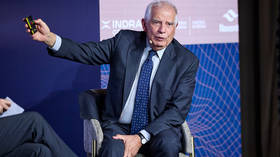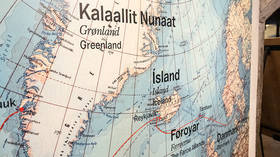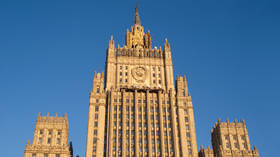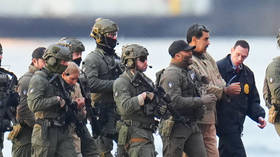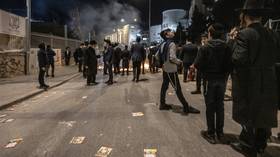South Korea ‘knocking at Eurasian door’
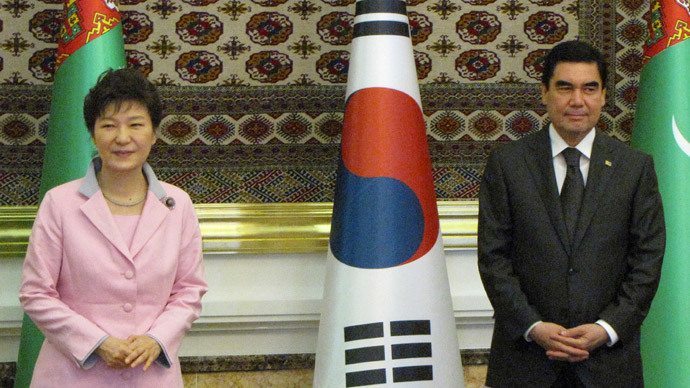
Days after the US and the EU threatened Russia with more sanctions, following its gas row with Ukraine, unexpectedly good news for President Putin came from Seoul – one of the key Washington’s allies in the Asia-Pacific.
South Korean President Park Geon-hye has ended a landmark trip to Central Asia, aimed at creating a huge single market to rival the EU and push for closer Eurasian energy cooperation.
‘Eurasian initiative’: Made in Korea
If implemented, President Park’s project will deal a further blow to the already shattered Western policy of isolating Russia. Moreover, it will make Moscow a centerpiece of “Eurasian initiative,” a brainchild of South Korea’s first female president, which falls in line with President Putin’s own aspirations and integration initiatives on the post-Soviet space in the vast Asia-Pacific region.
President Park’s six-day tour, which included her visits to Uzbekistan, Kazakhstan and Turkmenistan and brought a rich crop of multi-million energy and infrastructure contracts, has laid the groundwork for closer economic ties with the Central Asian nations, linking Asia with Europe.
“We should connect energy infrastructure, such as a power networks, gas and oil pipelines in the region, and push for Eurasian energy cooperation in a win-win situation, such as jointly developing shale gas in China and oil and gas in East Siberia,” – President Park said last October at a conference, unveiling her “Eurasian initiative.”
Already at that time, the South Korean leader called for the binding of Eurasian nations closer together by linking roads and railways for the construction of a multi-purpose logistics networks. The initiative features two things: building a “Silk Road Express” (SRX) and establishing vast energy networks. Apart from its huge oil and gas reserves, Russia’s role in the project, as it is seen in Seoul, is determined by its geography – Russia’s territory acquires a large part of Eurasia’s landmass. The proposed Trans-Siberian express will start from South Korea’s Busan and extend to London via North Korea and Russia.
Once the SRX is connected, transportation time from South Korean Busan to locations in Europe will only take 14 days as opposed to the current 45 days, which involves travelling through the Suez Channel, according the South Korea’s National Unification Advisory Council. South Korean President Park Geon-hye believes that the new Eurasia will offer fresh opportunities for investment and job opportunities by becoming an integrated continent to lead future generations.
Addressing the vast Korean diaspora
President Park’s trip to Central Asia also served as an occasion to shed light on the possible role ethnic Koreans of the post-Soviet regions could assume in consolidating partnership between South Korea and the newly-independent states. About 400,000 ethnic Koreans live in the former Soviet republics, with more than 280,000 of them settling in the three nations, visited by the South Korean leader last week.
Commenting on the issue, leading Korean media and political pundits say various measures should be implemented to help connect the descendants of Koreans who fled Japan’s colonial rule on the peninsula. One of the aims of President Park’s visit was to promote transnational “Korean identity” by revitalizing cultural ties and making it easier for ethnic Koreans from the region to visit and stay here.
Russian Koreans are also set to play quite a role. It is reported that a number of ethnic Korean-Russians are seeking to enter South Korea form Moscow via the demilitarized zone of Panmunjom, to commemorate the 150th anniversary of migration to Russia. The first Korean settlers began fleeing to Russia in 1864. Later some of them were forcibly resettled in Uzbekistan, Kazakhstan and other Soviet republics.
As President Park came up with her “Eurasian initiative,” the Rally Organization Committee ( ROC) consisting of 40 Koreans from Russia came up with a plan to make the trip from Moscow to North Korean and then to South Korea’s Busan “to draw a line of unification.”
It is reported that the committee wants the ethnic Korean-Russians delegation to visit the Gaeston Industrial Complex (GIC) in the border area and Panmunjom to “support peaceful relations and unification.” ROC wants the group to arrive in GIC on August 15, Independence Day. If permission is received from Pyongyang the trip may start as early as the first week of July, according to South Korea’s Ministry of Foreign Affairs.

Korean Peninsula: a long way to peace and reconciliation
Forging closer Central Asia economic ties and playing the “Korean diaspora” card can be seen as the key to making President Park’s “Eurasian Initiative” a reality and turning South Korea into one of the key players in the region. It must be noted that President Park has discussed the issue of the Trans-Siberian Railway with President Putin already twice last year. However, little progress has been made, so far mainly due to hostile inter-Korean ties. So, the future of the “Eurasia Initiative” largely depends on relations between the North and the South, and a wide range of related security and other issues.
The situation in the Korean Peninsula and major security concerns emanating from the dangerous stand-off between South and North Korea has become a subject of ongoing debate, involving generations of political and public figures, experts and political pundits in the Asia-Pacific and far beyond. The discussion, often seen as an exchange of heated rhetoric between the parties involved was kick-started in the early 1950s. The Korean war – one of the most distinct moments in the global rivalry of the cold-war era split Korea into two hostile states.
Nearly six decades after the major divisive line split the Korean Peninsula into two disjoined parts, the debate on the core existential question “How to handle the Korean crisis” has fitted well into the 21st century security agenda, with no quick solution in sight seen by the world powers involved in the six-party talks on the Korean crisis.
International efforts aimed at bringing the North Korea hermit state to the negotiations table and making it abandon its weapons of mass destruction (WMD) programs were never a diplomatic picnic. It was always a bumpy road, full of zigzags and dramatic turnarounds. In fact, very modest progress achieved in decades was largely overshadowed by muscle-flexing, missile tests and military drills, seen as the major deterrent instruments for the North. Complicating the negotiating process, the few genuine diplomatic efforts were plagued by the great powers’ hidden agendas and rivalry, a regional tug-of-war and the North Korean leaders’ desire to obtain deadly weapons and delivery systems at any cost.
This was the case 40, 30, 20 years ago and this is how things stand now. With the Kim ruling dynasty in North Korea showing powerful survival instincts, with no signs that the bizarre regime will eventually collapse due to its mounting socio-economic problems, six-party diplomacy may well look like a futile exercise or cat-and-mouse play.
While looking for renewed efforts to unravel the Korean riddle, or rather, untie the Korean knot, one must understand the very nature of the nuclear gamble, which has been staged by North Korea’s successive leaders. All hopes that the young North Korean leader might adopt a more conciliatory stance and start his reset policy with South Korea have failed. The expectations of rapprochement faded away last spring, when the region found itself on the brink of another large-scale military conflict.
There is more than one reason to believe why the Korean peninsula risks remaining a powder keg for the world in coming years. The first reason is the common plain logic of the North Korean leadership. This logic is built on the notion that with the nuclear baton in its hand, it would never be attacked by the West and its Asia-Pacific allies. So, nuclear weapons are de-facto a guarantee that the hermit regime will never become a subject of outside military intervention, like in Libya or Syria.
The new North Korean leader cited this reason while unveiling his ambitious nuclear arms development program last April.
The second reason why nuclear arms are so dear to the hearts of North Korean leaders is rooted in the fact that they have already got used to regard nuclear threat as some sort of North Korean “strategic commodity,” effectively traded to the West to get much-needed rice, fuel and basic commodities in return. For the isolated North Korean economy, desperate for cash and technologies, the nuclear bomb is not only an instrument to deter neighbors, but also a major bread-winner. The nuclear cat-and-mouse game with the members of the six-party talks in recent years and decades has many times helped the North to get much-needed food stuffs, fuel for electric power plants, and more.
The third reason why the WMD programs eventually became a “do-or-die” test North Korea is related to the very ideological foundation of the North Korean regime. Successive representatives of the Kim ruling dynasty were traditionally styling themselves as a living pinnacle of the Juche idea – North Korea’s official philosophy of self-reliance.
Acquiring WMD is respectively seen by North Korean ideology as a necessary precondition for building the land of Juche – strong and prosperous, ready to show big teeth to the Americans and their allies.
The escalating Ukrainian crisis, which has already led to major disruption internationally and caused the US and Russia to lock horns on many global issues, may cripple the six-party talks on the Korean crisis even further.
However, the situation in the Korean Peninsula is a reminder that world powers should not be involved in zero sum games, but rather unite their efforts to meet the major threats and challenges, emanating from the North-South standoff.
What is at stake is not only the “Eurasian Initiative” of President Park and the related integration plans, which may eventually change the face of Eurasia, but also the stability and security of the vast region, where Russia and South Korea are major players.
The statements, views and opinions expressed in this column are solely those of the author and do not necessarily represent those of RT.
The statements, views and opinions expressed in this column are solely those of the author and do not necessarily represent those of RT.



